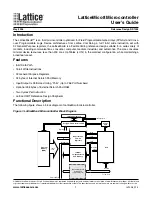
Electrical characteristics
STM32L151xC STM32L152xC
76/135
DocID022799 Rev 10
Figure 17. HSE oscillator circuit diagram
1. R
EXT
value depends on the crystal characteristics.
Low-speed external clock generated from a crystal/ceramic resonator
The low-speed external (LSE) clock can be supplied with a 32.768 kHz crystal/ceramic
resonator oscillator. All the information given in this paragraph are based on
characterization results obtained with typical external components specified in
. In
the application, the resonator and the load capacitors have to be placed as close as
possible to the oscillator pins in order to minimize output distortion and startup stabilization
time. Refer to the crystal resonator manufacturer for more details on the resonator
characteristics (frequency, package, accuracy).
Table 30. LSE oscillator characteristics (f
LSE
= 32.768 kHz)
(1)
1. Guaranteed by characterization results, not tested in production.
Symbol
Parameter
Conditions
Min
Typ
Max
Unit
f
LSE
Low speed external oscillator
frequency
-
-
32.768
-
kHz
R
F
Feedback resistor
-
-
1.2
-
M
Ω
C
(2)
2. Refer to the note and caution paragraphs below the table, and to the application note AN2867 “Oscillator
design guide for ST microcontrollers”.
Recommended load capacitance
versus equivalent serial
resistance of the crystal (R
S
)
(3)
3. The oscillator selection can be optimized in terms of supply current using an high quality resonator with
small R
S
value for example MSIV-TIN32.768kHz. Refer to crystal manufacturer for more details.
R
S
= 30 k
Ω
-
8
-
pF
I
LSE
LSE driving current
V
DD
= 3.3 V, V
IN
= V
SS
-
-
1.1
µA
I
DD (LSE)
LSE oscillator current
consumption
V
DD
= 1.8 V
-
450
-
nA
V
DD
= 3.0 V
-
600
-
V
DD
= 3.6V
-
750
-
g
m
Oscillator transconductance
-
3
-
-
µA/V
t
SU(LSE)
(4)
Startup time
V
DD
is stabilized
-
1
-
s
26&B287
26&B,1
I
+6(
WRFRUH
&
/
&
/
5
)
670
5HVRQDWRU
&RQVXPSWLRQ
FRQWURO
J
P
5
P
&
P
/
P
&
2
5HVRQDWRU
DLE
















































